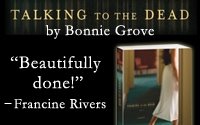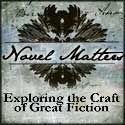 N. J. Lindquist is an award-winning author and speaker whose realistic stories, ironic humour, and godly compassion encourage others to examine both their lives and their relationships with God and other people. Passionate about seeing people become everything God created them to be, N. J. has influenced many through her writing, speaking, and mentoring. Her fiction includes two adult mysteries in the classic style and five coming-of-age novels that both guys and girls will read. Her nonfiction includes Hot Apple Cider (www.hotapplecider.ca).
N. J. Lindquist is an award-winning author and speaker whose realistic stories, ironic humour, and godly compassion encourage others to examine both their lives and their relationships with God and other people. Passionate about seeing people become everything God created them to be, N. J. has influenced many through her writing, speaking, and mentoring. Her fiction includes two adult mysteries in the classic style and five coming-of-age novels that both guys and girls will read. Her nonfiction includes Hot Apple Cider (www.hotapplecider.ca). N.J. is also a mentor to many writers, in particular Canadian writers. She is the co-founder of The Word Guild, an organization you've heard me make mention of from time to time. She's a great friend to many, and I'm privileged to be among those who call her "friend".
She's here on Fiction Matters to talk about that pesky POV.
POV? What is it? What do I do with it? Where can I get me some? POV (point of view) is critical. Read this great starter on what it is, and how you can get it working for your fab fiction.
Fiction that Matters from N.J. Lindquist:
Glitter of Diamonds
After an outspoken sports Toronto talk-show host asks on-air for a volunteer to knock some sense into the home teams temperamental new Cuban pitcher, Toronto homicide detectives Paul Manziuk and Jacqueline Ryan have to hustle to catch a murderer swinging a lethal bat.
After an outspoken sports Toronto talk-show host asks on-air for a volunteer to knock some sense into the home teams temperamental new Cuban pitcher, Toronto homicide detectives Paul Manziuk and Jacqueline Ryan have to hustle to catch a murderer swinging a lethal bat.
Review:
“In her 2nd mystery after Shaded Light, Lindquist, a master of plotting, seeds her tale with concealed clues and innuendoes that keep readers guessing until the very end. Reminiscent of golden age mysteries...” Library Journal


Shaded Light
“Ontario police detectives Paul Manziuk and Jacqueline Ryan make an odd team—he’s white, an abrupt, patronizing veteran, while she’s a recently promoted, vivacious black woman—but in Lindquist’s debut mystery the two rub elbows and tempers to captivating effect.” Publishers Weekly
 Circle of Friends series
Circle of Friends seriesThis is a coming-of age series of four novels that take an ordinary, average, 17-year-old Glen Sauten through an unexpectedly tumultuous senior year in high school, and eventually into a better place emotionally, socially, and spiritually.
Review:
“I meet with a lot of teens and speak to a lot of youth groups. I see the things they go through in N.J.s novels. The authenticity of Glen’s (main character) journey is impressive. I kept thinking how is she going to be able to top this book, but she did - each book got better and better.” Herbie Kuhn, In-house Voice of the Toronto Raptors
 In Time of Trouble
In Time of Trouble
Twin brothers Shane and Sandy Donahue were best friends until the summer before their final year of high school. Now they are almost enemies, and Shane wonders if his world wouldn’t be better off without him in it.
Review:
“Your book, In Time of Trouble, has assisted youth in dealing with issues like anger, fear and peer pressure. I can think of no more nobler cause than helping our youth in dealing with the complexities of growing up in the new millennium.” York Region Police Chief Armand La Barge
“I meet with a lot of teens and speak to a lot of youth groups. I see the things they go through in N.J.s novels. The authenticity of Glen’s (main character) journey is impressive. I kept thinking how is she going to be able to top this book, but she did - each book got better and better.” Herbie Kuhn, In-house Voice of the Toronto Raptors
 In Time of Trouble
In Time of TroubleTwin brothers Shane and Sandy Donahue were best friends until the summer before their final year of high school. Now they are almost enemies, and Shane wonders if his world wouldn’t be better off without him in it.
Review:
“Your book, In Time of Trouble, has assisted youth in dealing with issues like anger, fear and peer pressure. I can think of no more nobler cause than helping our youth in dealing with the complexities of growing up in the new millennium.” York Region Police Chief Armand La Barge
POV
Think of the book To Kill a Mockingbird. A classic because it has so much to say to us about human nature. But think—whose viewpoint do we get here? You have Scout remembering what happened in her childhood.
What if the author had chosen instead to give us Atticus’s viewpoint (Scout’s dad, who was a lawyer)? How would the book have been different?
What if the viewpoint character had been Boo Radley, a hermit few people knew? You would then have had a completely different story.
Or think about Moby Dick. The book is told from the first person (“Call me Ishmael.”) but not told from the main character’s viewpoint. How would the book have been different if Ahab had been telling the story? What if it had been written from the whale’s viewpoint?
The angle you use to tell your story is one of the key components. It should not be chosen as a matter of course, using whatever comes to your mind when you begin, but needs to be thought out and planned carefully.
For different reasons, my teen novels are all first person viewpoint, with one individual telling the entire story.
When I started my mystery, Shaded Light, I wrote from the viewpoint of a single character. But about 30,000 words into the book, I realized it just wasn’t working. A single character’s viewpoint was too limited for the story I wanted to tell. I rewrote the whole thing from the viewpoint of one of the police people. But that didn’t work either. In the end, after putting the book aside for some time, I ended up combining the viewpoints of a number of individuals involved in the scene of the crime and the two primary police people. I wound up with 14 different viewpoints, and I felt I was weaving many different stories together, which was tricky, but it works!
So how do you decide on your point of view?
I like to think of it this way: there are other people in the room, but you have a telescope and something is happening outside the room that only you can see. All the other people know is what you tell them.
Because you are in control, you can choose exactly how much or how little you will let others see others see. You can offer them a peephole through which they can glimpse little bits and pieces, or you can put them right inside the characters’ heads so they see the whole picture.
You can even move them in and out, back and forth, now using the zoom lens, now seeing from a wide perspective. You are in complete control.
When you choose your POV style and character or characters, you are saying, “This is how I want the reader to see, and he or she will see thorough this particular character’s eyes.”
A point-of-view character, according to Nancy Kress who writes for Writer’s Digest, is “the person though whose eyes we experience the story. We see what he sees, hear what he hears, know what he knows.”
And of course, what he sees, hears, and knows is no more nor less than what you make it.
***
Okay, I confess! I have a favorite POV. I love to read and write first person. I enjoy the sense of immediacy and intimacy I get reading a first person novel. When I write, my first instinct is to use first person. But, as N.J. pointed out, not all stories are made to be told in just one POV.
Do you have a favorite? Have you tried writing something in one POV and found it worked better in a different one?
Share you stories, ask N.J. questions, or just leave a comment about the subject. We love to hear from you!
I bid you good writing.










No comments:
Post a Comment